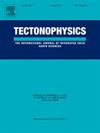Seismic structure of African slab beneath Antalya bay southern Turkey
IF 2.7
3区 地球科学
Q2 GEOCHEMISTRY & GEOPHYSICS
引用次数: 0
Abstract
In this passive seismic tomography study, we examined the seismic structure of the African slab beneath the Antalya coast, extending from the Isparta Angle to the island of Cyprus, using regional data. The southern part of Turkey, adjacent to the Mediterranean Sea, has a highly complex structure due to a wide range of tectonic and geodynamic processes, contributing to the high seismic activity of the region. We collected a 14-year data catalog from AFAD (T. C. Ministry of Interior Disaster and Emergency Management Department Earthquake Department Directorate). The resulting dataset contained the arrival times of 66,805 P-waves and 46,197 S-waves from 6158 events, which were used to produce high-resolution seismic tomography models down to 120 km depth. The results revealed a low-velocity anomaly beneath the Paphos fault at a depth of approximately 70 km, which may indicate a rupture between the Cyprus and Antalya slabs. Moreover, the Antalya slab seems to become thinner at this depth. The structure of the continental crust of the Anatolian Plate under the Central Taurus Mountains is characterized by two anomalies: an upper high-velocity and a lower low-velocity one. This indicates the heating of the lower crust from the ascending asthenospheric flow penetrated through the gap between the Antalya and Cyprus slabs. The research findings made it possible not only to clarify the structure of the African slab beneath the Antalya coast, but also to detect local heterogeneities not investigated previously.
土耳其南部安塔利亚湾非洲板块的地震结构
在这项被动地震层析成像研究中,我们利用区域数据考察了安塔利亚海岸下方非洲板块的地震结构,该板块从伊斯帕尔塔角延伸至塞浦路斯岛。土耳其南部毗邻地中海,由于各种构造和地球动力学过程,该地区的结构非常复杂,因此地震活动频繁。我们从 AFAD(土耳其内政部灾害和应急管理司地震局)收集了 14 年的数据目录。由此产生的数据集包含了 6158 个地震事件中 66805 个 P 波和 46197 个 S 波的到达时间,用于制作深度达 120 千米的高分辨率地震层析成像模型。结果显示,帕福斯断层下约 70 千米深处有一个低速异常点,这可能表明塞浦路斯板块和安塔利亚板块之间发生了断裂。此外,安塔利亚板块在这一深度似乎变得更薄。金牛山中部下的安纳托利亚板块大陆地壳结构有两个异常点:上部高速异常点和下部低速异常点。这表明通过安塔利亚板块和塞浦路斯板块之间的缝隙穿透的上升岩流加热了下地壳。研究结果不仅澄清了安塔利亚海岸下非洲板块的结构,还发现了以前未调查过的局部异质性。
本文章由计算机程序翻译,如有差异,请以英文原文为准。
求助全文
约1分钟内获得全文
求助全文
来源期刊

Tectonophysics
地学-地球化学与地球物理
CiteScore
4.90
自引率
6.90%
发文量
300
审稿时长
6 months
期刊介绍:
The prime focus of Tectonophysics will be high-impact original research and reviews in the fields of kinematics, structure, composition, and dynamics of the solid arth at all scales. Tectonophysics particularly encourages submission of papers based on the integration of a multitude of geophysical, geological, geochemical, geodynamic, and geotectonic methods
 求助内容:
求助内容: 应助结果提醒方式:
应助结果提醒方式:


